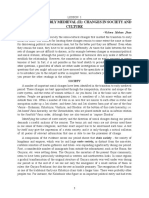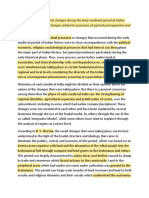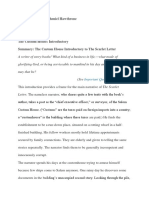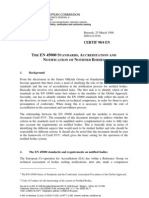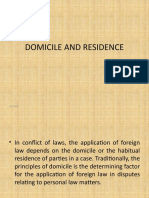0 ratings0% found this document useful (0 votes)
9 viewsIgnou Hoiii
Ignou Hoiii
Uploaded by
Komal SahaniThe document discusses B.D. Chattopadhyaya's view of the emergence of Rajputs as a process of 'Rajputization' involving political, economic, and social developments. It examines how expansion of agriculture led to the growth of new settlements and lineages. Tribes gained status as Kshatriyas, and lineages fabricated genealogies to seek legitimacy and social mobility.
Copyright:
© All Rights Reserved
Available Formats
Download as RTF, PDF, TXT or read online from Scribd
Ignou Hoiii
Ignou Hoiii
Uploaded by
Komal Sahani0 ratings0% found this document useful (0 votes)
9 views17 pagesThe document discusses B.D. Chattopadhyaya's view of the emergence of Rajputs as a process of 'Rajputization' involving political, economic, and social developments. It examines how expansion of agriculture led to the growth of new settlements and lineages. Tribes gained status as Kshatriyas, and lineages fabricated genealogies to seek legitimacy and social mobility.
Original Title
ignou hoiii
Copyright
© © All Rights Reserved
Available Formats
RTF, PDF, TXT or read online from Scribd
Share this document
Did you find this document useful?
Is this content inappropriate?
The document discusses B.D. Chattopadhyaya's view of the emergence of Rajputs as a process of 'Rajputization' involving political, economic, and social developments. It examines how expansion of agriculture led to the growth of new settlements and lineages. Tribes gained status as Kshatriyas, and lineages fabricated genealogies to seek legitimacy and social mobility.
Copyright:
© All Rights Reserved
Available Formats
Download as RTF, PDF, TXT or read online from Scribd
Download as rtf, pdf, or txt
0 ratings0% found this document useful (0 votes)
9 views17 pagesIgnou Hoiii
Ignou Hoiii
Uploaded by
Komal SahaniThe document discusses B.D. Chattopadhyaya's view of the emergence of Rajputs as a process of 'Rajputization' involving political, economic, and social developments. It examines how expansion of agriculture led to the growth of new settlements and lineages. Tribes gained status as Kshatriyas, and lineages fabricated genealogies to seek legitimacy and social mobility.
Copyright:
© All Rights Reserved
Available Formats
Download as RTF, PDF, TXT or read online from Scribd
Download as rtf, pdf, or txt
You are on page 1of 17
iii) Recent View: Processual Theory
B. D. Chattopadhyaya examines the emergence of the
Rajputs as a process which he has called as process of
‘Rajputization’. He also suggests that the claims by
different Rajput clans were actually a process to
‘dynasticize’, in which different periods and different
regions was not almost alike but differed in context of
time and place. According to him, their emergence should
not be looked in terms of ancestry.The term rajputra in
early medieval literary texts and inscriptions, in reality,
represented a mixed caste constituting a fairly large
section of petty land holding chiefs. The status of the clan
was generally counted a lot during the early medieval
period, which was known for hereditary offices and a
stereotype system of administration. The contemporary
status of the clan was , thus, the criterion for the inclusion
in the Rajput clans mentioned in Rajatarangini,
Kumarapalcharita and Varnaratnakara. It is to be noted
that the list of 36 clans mentioned in all the literary texts
is dissimilar. Political dominance may altogether be the
prominent criterion which might have added to the status
of a clan. Thus, it was perhaps owing to the political
dominance of the Pratiharas and Chahamanas that their
name was retained regularly in the lists. He suggests that
the process of the emergence of Rajputs in early medieval
records is found linked with political, economic and
social developments.
B.D. Chattopadhyaya talks about two processes: one, the
territorial expansion and colonization of the area and
other, the upward movement within the Brahmanical
hierarchy of Varna system. Chattopadhyaya illustrated the
growth of agriculture based economy leading to new
agrarian settlements that ultimately led to the making of
new political groups, who in order to gain more power
tried to legitimize their position through several means.
This expansion led to the emergence of new lineages in
the newly settled areas, for example Chahmanas settled in
sapadalaska area gradually branched off into other
lineages.
The colonization of new areas resulted in the expansion of
a number of settlements and also of agrarianeconomy. The
comparison of the list of early historic sites with those of
early medieval period and appearance of new place names
in the contemporary inscriptions clearly suggest an
increase in the number of settlements. The inscriptions of
the western and central India also refer tothe territorial
expansion of the Rajput power by suppressing the tribal
settlements of the Bhils, Pulindas and Sabaras. The
Guhila kingdom was founded in the 7th century on the
Bhil settlements, according to tradition.
Similar movements of expansion are found in case of the
Chahamanas of Nadol. Shakambhari – the capital of the
main line of the Chahamaans –also came out of the
colonization, which was earlier a forest
land(jangaladesha). The present region of Rajasthan,
according to
Chattopadhyaya, in the period when Rajput polity was
beginning to emerge was in its various areas undergoing a
process of change from tribalism Mobility to Kshatriya
Status: All the Rajput clans did not emerge out of the
process of colonization. The Meds reached to the Rajput
status from a tribal background and the other group,
namely Hunas, were assimilated in Indian society and
acquired the status of Kshatriyas. Thus, a criterion for the
inclusion of the Meds and Hunas was mobility to
Kshatriya status which was more commonly practiced.
For the majority of other newly emerging royal lines
Brahma-Kshatra was a transitional status.
Chattopadhyaya opines that brahma-kshtra might have
been an open status
during the early medieval period.
Political Eminence: The Gurjara-Pratiharas emerged out
of different stocks
of the Gurjaras acquiring political eminence in western
India. However, in
their inscriptions they have variously claimed their origin
either from
Brahman, Sun, Indra etc. in order to maintain the
ancestral respectability.
The sovereign or ruling families of a clan had a general
tendency to frame
the genealogies with respectable ancestry. It seems that a
definite co-relation
did exist between the political eminence and a movement
towards
corresponding social status
Chahamana territory is identified with Sakambhari
(Sapadalaksa), present day Sambhar area in Rajasthan.
Sapadalaksa actually means one and a quarter lakh, so
perhaps it was the number of settlements in the area.
Scholars like B.D. Chattopadhyaya discuss agrarian
growth in the region during early medieval centuries and
the emergence of Rajputs as controllers of large group of
settlements which led to their growth as landed
aristocracy.
Gradually, there was an upward mobility in economic,
political and social spheres as well. As land under their
control increased, they branched off, leading to the rise of
other ruling lineages. For example, the Nadol branch of
Chauhans moved to the Pali district of Rajasthan at a later
period.
Expansion of agriculture in tribal areas marks an essential
feature for development of new lineages. Peasantization
of tribes lead these tribes to become part of the
mainstream. One can associate this with the expansion of
Guhilas from Gujarat in southern Rajasthan by displacing
the local tribal Bhils of the area. Similarly, the Nadol
branch of Chahamanas displaced and assimilated the local
Medas and Minas. This entire theory basically revolved
around the concept of expansion of agriculture and better
economy. This also leads to the concept of tribal’s
acquiring the status of Kshatriya and hence becoming
Rajputs.
Different lineages of Rajputs can be better understood by
the process of political developments and stratification
over a period of time. Throughout the period, lineages
tried to seek legitimacy that was aided by the fabrication
of genealogies drafted by their bards. The mythological
traditions were acts of seeking legitimacy for rulers
coming from obscure backgrounds. Lineages from the
reputable ancestry were sought after by the new warrior
classes to have them acknowledged in the society. Such
attempts were also made by landed aristocracy to acquire
upward social and political mobility. By landed
aristocracy we mean the new social groups who acquired
control over large tracts of agricultural lands.
This obviously happened due to expansion of agriculture
during early medieval centuries. Similar developments
can also be seen in the case of other regions where
dominant land-holding groups emerged over a period of
time.
Upward mobility within the hierarchy of political
structure can be explained by transformation from being a
subordinate to an independent ruler. This basically related
with the concept of attaining a Kshatriya status first, then
a feudatory and ultimately a sovereign ruler. This upward
mobility was basically associated with the growth of
economic and military power. For example, Chahamanas,
Guhilas and Chalukyas were subordinates of Gurjara-
Pratiharas and later became independent rulers.
Chattopadhyaya also suggests that merely acquiring the
status of Rajput was not enough but maintaining it by
consolidating one’s position was also a feature of this
period.
This was facilitated by the distribution of land among the
kin and clan by which they ensured their expansion and
acquiring of resources. This distribution of land was
related to the
expansion of their geographical territories as well as
political authority. To consolidate it further, this process
was aided by constructing fortresses on massive
scaledone in order to have a defense mechanism and as
well as a mark of authority on the nearby areas. To
strengthen it further, they engaged themselves in
matrimonial alliance with other clans and started a
collaboration of social and political activities. This entire
process of ‘Rajputization’ led to giving them a political
status which gradually became hereditary. Thus, the
recent perspectives on Rajputs have perceived the entire
process of change as the result of interplay of several
factors. At the same time, the processes were distinct for
each region.
Agrarian and Territorial Settlements: The colonization of
new areas
resulted in the expansion of a number of settlements and
also of agrarian
economy. The comparison of the list of early historic sites
with those of
early medieval period and appearance of new place names
in the
contemporary inscriptions clearly suggest an increase in
the number of
settlements. The inscriptions of the western and central
India also refer to
the territorial expansion of the Rajput power by
suppressing the tribal
settlements of the Bhils, Pulindas and Sabaras. The
Guhila kingdom was
founded in the 7th century on the Bhil settlements,
according to tradition.
Similar movements of expansion are found in case of the
Chahamanas of
Nadol. Shakambhari – the capital of the main line of the
Chahamaans –
also came out of the colonization, which was earlier a
forest land
(jangaladesha). The present region of Rajasthan,
according to
Chattopadhyaya, in the period when Rajput polity was
beginning to emerge
was in its various areas undergoing a process of change
from tribalism Mobility to Kshatriya Status: All the
Rajput clans did not emerge out of
the process of colonization. The Meds reached to the
Rajput status from a
tribal background and the other group, namely Hunas,
were assimilated in
Indian society and acquired the status of Kshatriyas. Thus,
a criterion for
the inclusion of the Meds and Hunas was mobility to
Kshatriya status
which was more commonly practiced. For the majority of
other newly
emerging royal lines Brahma-Kshatra was a transitional
status.
Chattopadhyaya opines that brahma-kshtra might have
been an open status
during the early medieval period.
Political Eminence: The Gurjara-Pratiharas emerged out
of different stocks
of the Gurjaras acquiring political eminence in western
India. However, in
their inscriptions they have variously claimed their origin
either from
Brahman, Sun, Indra etc. in order to maintain the
ancestral respectability.
The sovereign or ruling families of a clan had a general
tendency to frame
the genealogies with respectable ancestry. It seems that a
definite co-relation
did exist between the political eminence and a movement
towards
corresponding social status.
Mobility from Feudatory to Independent Status: Some of
the Rajput
clans emerged out from the feudatory to the independent
status, as is clear
from the genealogical claims. The case of Gurjaras of
Gujarat, Guhilas of Kiskindha and Dhavagarta, Guhilas of
Mewar, Chahamanas of Gujarat and
Rajasthan was a case of transition from feudatory to
independent status.
This transition and upward mobility was a result of the
growth of the
military strength. The emergence of the Rajputs, thus, in
the existing
hierarchical political structure was not sudden but a
gradual process.
The System of Land Distribution: The process of the
emergence of early
Rajputs is associated at the level of economy, with certain
new features of
land distribution and territorial system. One feature of
land distribution, the
trend of which appears to have been higher in Rajasthan,
was the distribution
of land among royal kinsmen. This practice was common
among the
Pratihara, Chahamana, and Guhila clans. Such land
assignments were also
hereditary in nature. The specific thing was that while the
other assignees
were not authoritative to grant land independently out of
their holdings and
depended on the approval of the king, the kinsmen needed
no such sanction
and could make grant independently without king’s
approval.
Fortifications: The Rajput clans strengthened themselves
by maintaining
military power, one of the chief features of which was the
construction and
maintenance of forts. The inscriptions of the early
medieval period mentions
about a number of fortresses in Rajasthan. Besides
serving the defence
purpose, the forts played wider functions such as
maintaining linkage with
big landholdings and existing composition of population.
Rajasthan was a
cradle land of such fortresses. Forts, thus, represented a
process of
consolidation of ruling clans.
Inter-clan Relations: At the level of social relations, the
consolidation of
the Rajput clans and the acceleration of the process of
“Rajputization”
were through the marriage network among the clans
(inter-clan
relationships). The inter-clan relations maintained through
marriage network
provided social legitimacy. These marriages may have led
to collaboration
in wider areas of social and political activity. The new
clans and the
recognized sub-divisions of earlier clans were brought
into the Rajput
network by a few cases of marriage of which records are
available. The
consolidation of Rajput ascendency was also due to the
circulation of clan
members in different kingdoms and courts and their
participations at various
levels of polity
You might also like
- Hill and Jones Chapter 4 Strategy at Functional LevelDocument31 pagesHill and Jones Chapter 4 Strategy at Functional LevelRommel de VeraNo ratings yet
- Rajput KingdomDocument4 pagesRajput KingdomRamita Udayashankar88% (8)
- Origin of RajputsDocument7 pagesOrigin of RajputsLettisha Liju100% (1)
- Rajput EmergenceDocument3 pagesRajput EmergencelawrininiangfounderNo ratings yet
- Origin of Rajputs1Document3 pagesOrigin of Rajputs1Tanishka shrivastavaNo ratings yet
- CC5 Mod 3CDocument7 pagesCC5 Mod 3CAparupa RoyNo ratings yet
- Unit 2Document11 pagesUnit 2Ravi SinghNo ratings yet
- Mhi 04 Block 02Document54 pagesMhi 04 Block 02arjav jainNo ratings yet
- SM 1 MedievalDocument120 pagesSM 1 MedievalUjjalSahuNo ratings yet
- The Period From The Sixth To Fourth Century BCE Witnessed A Transition To A New Historical Scene in Northern India With The Establishment of KingdomsDocument8 pagesThe Period From The Sixth To Fourth Century BCE Witnessed A Transition To A New Historical Scene in Northern India With The Establishment of Kingdomsraman9001No ratings yet
- Characteristics of Early Mediaeval IndiaDocument7 pagesCharacteristics of Early Mediaeval Indiamama thakur100% (1)
- The Nature of State in Medieval South IndiaDocument11 pagesThe Nature of State in Medieval South IndiaamyNo ratings yet
- Trace The Pattern of Social Changes During The Early Medieval Period of Indian HistoryDocument5 pagesTrace The Pattern of Social Changes During The Early Medieval Period of Indian HistoryShabdita TiwariNo ratings yet
- Unit-4 Early State FormationDocument24 pagesUnit-4 Early State FormationPavan KalyanNo ratings yet
- SM-1 in EnglishDocument120 pagesSM-1 in EnglishShivamNo ratings yet
- Chola StateDocument4 pagesChola StateKanishkaNo ratings yet
- Aradhya Sinha History AssignmentDocument7 pagesAradhya Sinha History Assignmentsinhaaradhya12No ratings yet
- Nature of The Chola State PDFDocument4 pagesNature of The Chola State PDFNainaNo ratings yet
- Unit-2 (2) Rajputs OriginDocument14 pagesUnit-2 (2) Rajputs OriginAnimehaNo ratings yet
- Understanding CasteDocument94 pagesUnderstanding CasteManvendra Singh ShekhavatNo ratings yet
- Varna and JatiDocument3 pagesVarna and Jatilegacyundone2No ratings yet
- Chola StateDocument4 pagesChola StateMitali PandeyNo ratings yet
- Nature of State of Early Medieval India PDFDocument7 pagesNature of State of Early Medieval India PDFNitu KundraNo ratings yet
- Hoi 3Document6 pagesHoi 3Aditya SinghNo ratings yet
- Medieval India Agrarain ExpansionDocument6 pagesMedieval India Agrarain ExpansionHimanshu Thakuria100% (28)
- Nature of The Chola StateDocument5 pagesNature of The Chola StateArchita JainNo ratings yet
- Unit-37 Transition To Early Medieval IndiaDocument10 pagesUnit-37 Transition To Early Medieval IndiaYashika SinghNo ratings yet
- IntroductionDocument5 pagesIntroductionMoksh Kothari100% (1)
- The Origin of The Rajputs CritcicalDocument2 pagesThe Origin of The Rajputs CritcicallawrininiangfounderNo ratings yet
- MahajanpadasDocument35 pagesMahajanpadasSahil Raj RavenerNo ratings yet
- Indian Feudalism DebateDocument16 pagesIndian Feudalism DebateJintu ThresiaNo ratings yet
- Casteinpractice ShailMayaramDocument27 pagesCasteinpractice ShailMayaramSafwan AmirNo ratings yet
- Land Grants Early MediaevalDocument4 pagesLand Grants Early MediaevalArish IsaNo ratings yet
- Irfan BDocument11 pagesIrfan Bmehraj ud dinNo ratings yet
- Indian FeudalismDocument13 pagesIndian FeudalismZaheenNo ratings yet
- The Nature of The Indian States of The Early Medieval PeriodDocument4 pagesThe Nature of The Indian States of The Early Medieval PeriodKundanNo ratings yet
- Modern Asian StudiesDocument41 pagesModern Asian StudiesAkshitaNo ratings yet
- Nature of Chola State - Docx PresentationDocument8 pagesNature of Chola State - Docx Presentationpriyanka100% (7)
- Caste RadicalismDocument42 pagesCaste Radicalismnrk1962No ratings yet
- IntroductionDocument17 pagesIntroductionNamrata SinghNo ratings yet
- Rajput Period Was Dark Age of IndiaDocument24 pagesRajput Period Was Dark Age of Indiaraajivrao8363100% (1)
- Upinder Singh Why It May Be Wrong To Ask Whether India Is The Mother of Democracy - The WeekDocument14 pagesUpinder Singh Why It May Be Wrong To Ask Whether India Is The Mother of Democracy - The Weekkaala_yuvrajNo ratings yet
- The Early Kingdom of The Licchavis: Yogiraj - Co.inDocument3 pagesThe Early Kingdom of The Licchavis: Yogiraj - Co.inRabin Ale100% (1)
- Rajput Period Was Dark Age of IndiaDocument26 pagesRajput Period Was Dark Age of IndiaAnthony MunozNo ratings yet
- Sambhav: Answer 1Document5 pagesSambhav: Answer 1Muhammad ImranNo ratings yet
- Kushana PolityDocument5 pagesKushana PolityKunal100% (1)
- State Formation in Early Medieval IndiaDocument12 pagesState Formation in Early Medieval Indiaaditillb22103No ratings yet
- Social Changes - Peasantization - Profileration of CastesDocument6 pagesSocial Changes - Peasantization - Profileration of CastesSaejal KapoorNo ratings yet
- Unit 3 PDFDocument13 pagesUnit 3 PDFSudarshan ChaudhariNo ratings yet
- Early Medieval Period A Distinctive PhasDocument3 pagesEarly Medieval Period A Distinctive Phasmama thakurNo ratings yet
- Changing Political FormationsDocument67 pagesChanging Political FormationsLallan Singh100% (1)
- Unit 1Document17 pagesUnit 1Ravi SinghNo ratings yet
- Origins of Jagannath Cult in Odisha and The Debate On State FormationDocument47 pagesOrigins of Jagannath Cult in Odisha and The Debate On State FormationIshaan Zaveri100% (1)
- Social Changes PeasantizationDocument6 pagesSocial Changes PeasantizationChetna UttwalNo ratings yet
- Unit-1 Early State Formation PDFDocument17 pagesUnit-1 Early State Formation PDFSyedNo ratings yet
- Unit 1 Pre-State To State: StructureDocument63 pagesUnit 1 Pre-State To State: StructureNandhu DevanandanNo ratings yet
- Indian FeudalismDocument7 pagesIndian FeudalismRamita Udayashankar85% (27)
- Unit 7 Early Medieval Polities in Peninsular India 8 TO 12 Centuries A.DDocument12 pagesUnit 7 Early Medieval Polities in Peninsular India 8 TO 12 Centuries A.DPavan KalyanNo ratings yet
- The Headless State: Aristocratic Orders, Kinship Society, and Misrepresentations of Nomadic Inner AsiaFrom EverandThe Headless State: Aristocratic Orders, Kinship Society, and Misrepresentations of Nomadic Inner AsiaRating: 4 out of 5 stars4/5 (1)
- Gale Researcher Guide for: The Evolution of the Caste System in Early IndiaFrom EverandGale Researcher Guide for: The Evolution of the Caste System in Early IndiaNo ratings yet
- What Is LiteratureDocument13 pagesWhat Is LiteratureAnonymous q6iuQ2tNo ratings yet
- Case Study 1Document11 pagesCase Study 1toneyNo ratings yet
- Memorandum of Agreement 1Document3 pagesMemorandum of Agreement 1JOCOM & QUEZADA LAW FIRMNo ratings yet
- 225 Happy Birthday Wishes For The People in Your LifeDocument1 page225 Happy Birthday Wishes For The People in Your LifeJulia SemeniakNo ratings yet
- Grade 6 History Memo Nov 2019Document2 pagesGrade 6 History Memo Nov 2019samkedabaNo ratings yet
- Critical Essays Bstyle, Wit, and Irony in The Way of The WorldDocument5 pagesCritical Essays Bstyle, Wit, and Irony in The Way of The WorldRuxandra OnofrasNo ratings yet
- 1 21stCL-Q1-W5 With CoverDocument23 pages1 21stCL-Q1-W5 With CoverVictoria De Los SantosNo ratings yet
- Scarlet Letter by Natheniel Hawthrone SparknotesDocument246 pagesScarlet Letter by Natheniel Hawthrone SparknotesNAVDEEP KALSINo ratings yet
- Assignment-I Ag Kaung MyatDocument6 pagesAssignment-I Ag Kaung MyatAung Kaung MyatNo ratings yet
- EN 45000 SeriesDocument9 pagesEN 45000 SeriesMegame BakiNo ratings yet
- Western Civilization - A Concise History - Volume 3Document276 pagesWestern Civilization - A Concise History - Volume 3Yash TandonNo ratings yet
- Lancelot and GuinevereDocument9 pagesLancelot and GuineverePaulo PereiraNo ratings yet
- Educ 9Document22 pagesEduc 9d o sNo ratings yet
- RealizingWomensRightstoLand 2ndeditionDocument117 pagesRealizingWomensRightstoLand 2ndeditionVeronica EnNo ratings yet
- Basic Bible DoctrineDocument11 pagesBasic Bible DoctrineTony J McLaughlinNo ratings yet
- CIR Vs Filinvest Development CorpoDocument18 pagesCIR Vs Filinvest Development CorpoGabby ElardoNo ratings yet
- MIDTERM-ACTIVITIES-1-5 Art APDocument3 pagesMIDTERM-ACTIVITIES-1-5 Art APMeosjinNo ratings yet
- Asme Ix "Welding Qualification": 1 Online TrainingDocument8 pagesAsme Ix "Welding Qualification": 1 Online TrainingIqfal ZulhendriNo ratings yet
- Important Acts in India - All Important Acts and Reforms Till 2023 - PWOnlyIASDocument26 pagesImportant Acts in India - All Important Acts and Reforms Till 2023 - PWOnlyIASkumaralokyadav14No ratings yet
- Edc PDF Unit 1Document26 pagesEdc PDF Unit 1Karthikeyan V MechanicalNo ratings yet
- Domicile and Habitual ResidenceDocument18 pagesDomicile and Habitual ResidenceSuditi TandonNo ratings yet
- Topic Vocabulary - Clothes and FashionDocument19 pagesTopic Vocabulary - Clothes and FashionCarlo FuntanillaNo ratings yet
- JĘZYK_ANGIELSKI_–_arkuszDocument13 pagesJĘZYK_ANGIELSKI_–_arkuszHsin Ju LeeNo ratings yet
- Aditya's NotesDocument8 pagesAditya's NotesNavya BhandariNo ratings yet
- Miranda KerrDocument25 pagesMiranda KerrKemberly Semaña PentonNo ratings yet
- The Public Ministry of Jesus: NaziriteDocument4 pagesThe Public Ministry of Jesus: NaziriteKim Liat100% (1)
- Knives Illustrated - September, October 2015Document84 pagesKnives Illustrated - September, October 2015Ivana Stojiljkovic100% (1)
- Mexican Legend About CornDocument2 pagesMexican Legend About CornAle Granados GuiaNo ratings yet
- Annex II - Cadastral Registration ProceedingsDocument1 pageAnnex II - Cadastral Registration ProceedingsMiGay Tan-PelaezNo ratings yet








